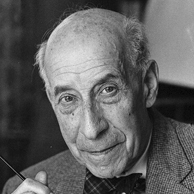
link esterni:
Josef Frank
architect - designer (1885 - 1967)
Josef Frank was born in Baden in 1885, architect, artist and designer of Austrian origin, he studied architecture at the Vienna Polytechnic where he graduated in 1910 with a thesis on the sacred architecture of Leon Battista Alberti.
Initially Frank dealt with public housing and residential complexes. Contrary to most Viennese architects of the interwar period, he adopted the idea of settlement and not the creation of superblocks of municipal housing. He rejects the decoration of facades, preferring functional forms.
From 1919 to 1925 he taught at the Vienna School of Arts and Crafts.
In 1925 Frank founded the interior design studio Haus & Garten (Home & Garden) together with colleagues Oskar Wlach and Walther Sobotka.
In 1932 he was among the founders of the Vienna Werkbund, initiator and leader of the Werkbundsiedlung project in Vienna.
In 1933, he fled to Sweden, to Stockholm, where he adopted Swedish citizenship in 1939, due to anti-Semitic persecution, where he continued his career as a leading designer of the interior design company Svenskt Tenn, hired by the company's founder, Estrid Ericson.
With Oskar Strnad he created the Vienna School of Architecture and the concept of modern houses, housing and interiors.
The collaboration with Svenskt Tenn continued even after moving to New York, to escape the Nazi advance in Europe.
Frank is influenced by local museum collections, for example his brightly colored botanical patterns for fabric designs, thought to derive from the Metropolitan Museum of Art's Indian "trees of life" motifs.
After Germany's defeat, Frank returned to Sweden, where he continued to work for Svenkst Tenn until his death in 1967.
In addition to his work in architecture, Josef Frank creates numerous designs for furniture, furnishing accessories, fabrics, wallpapers and carpets. He also dedicates himself to painting.
Well known for his fabric designs, Frank is a great admirer of William Morris, as seen in his stylized nature motifs, geometric order and repeating motifs.
Between January and May 2017, the Fashion and Textile Museum in London is dedicating an exhibition of textile designs to Josef Frank.
Products designed by Josef Frank:
The Liljevalch sofa from 1934 was the first piece of furniture designed by Josef Frank for Svenskt Tenn.
Model 526 dining chairs by Josef Frank for Svenskt Tenn, Sweden, 1934.
Bookcase with drawers, Joseph Frank, Svenskt Tenn, Sweden, ca. 1940
Desk, Joseph Frank, Svenskt Tenn, Sweden, ca. 1950
Floor lamp collection by Joseph Frank, Sweden, ca. 1950







